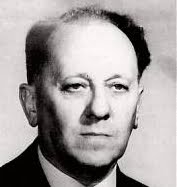Laszlo Kozma (1902)
As a development engineer, László Kozma primarily dealt with issues of automating telephone network switching technology. He also designed his early computer technology creations from components used in telephone technology. Far ahead of his time, he achieved the convergence of telecommunications and informatics as defined by today's concepts, already in the 1940s.
In 1930, as a junior engineer, he joined the American company Bell Telephone Manufacturing Company in Antwerp, Belgium. For a few years, he performed routine circuit design work, then gradually became involved in development work: he participated in the development of the so-called remote selection system for the national automatic telephone network of several European countries, and contributed to the development of new types of telephone exchanges (7E and MA). He was awarded 25 patents between 1934-1938.
Between 1938 and 1942, he was granted ten patents for developing electric calculators. (He is probably credited with the first patent, a "multi-user, multi-workstation computing system," which linked the calculator and teletype terminals.)
After returning home in 1942, he worked as a mechanic in the radio tube measurement department of the United Bulb. In 1944, he was called up for labor service and then deported to Mauthausen, from where he returned home after the camp was liberated.
After 1945, he was employed by the Standard Electricity Company in Budapest, where his task as chief engineer was to manage the reconstruction of the national telephone exchanges. (He was called back to Antwerp, but he wanted to build a global company from Standard.) In 1947-1948, he was appointed technical deputy director of the factory, and then technical director in 1948. In the same year, he became a professor at the Budapest State Technical College. In 1949, he participated in the founding of the Faculty of Electrical Engineering (VIK) at the Budapest University of Technology (BME), and was asked to head the Department of Wired Communications.
At the end of 1949, in connection with the Standard case, he was arrested on trumped-up charges and imprisoned. From 1952, he was a member of the engineering office formed from prisoners in the Budapest collective prison. In 1954, he was granted amnesty and released.
From 1955, he was the head of the Department of Wired Communications at BME until his retirement in 1972. He was also the Dean of the Faculty of Electrical Engineering at BME between 1960 and 1963. As Dean, he modernized the curriculum of electrical engineering education and established the Department of Electronics Technology at the Faculty of Electrical Engineering at BME.
He had already designed a decimal calculator (electromechanical calculator) in the 1930s. In the second half of the 1950s, with financial support from the Hungarian Academy of Sciences, he designed an electronic calculator, which he named MESZ-1 (University Calculator-1).
The MESZ-1 was the first program-controlled (but not storing instructions) calculator to be put into operation in Hungary. (The machine was built with 2000 pieces, ten types, then commercially available, cheap relays, which made its maintenance easier.) The machine was used in university education and in numerous industrial processes for many years.
In 1964, as a further development of the MESZ-1 for the Institute of Linguistics, he and Béla Frajka created the first Hungarian language statistical automaton – relay and vacuum tube – for the Institute of Linguistics, which was capable of simultaneously solving eighty different statistical tasks via punched tape data input.
In 1961, he was elected a corresponding member of the Hungarian Academy of Sciences, and then a full member in 1976. He was the chairman of the Telecommunication Scientific Association, then of the Telecommunications Committee. He was a member of the Telecommunication (later: Telecommunication and Informatics) Scientific Association (HTE) and the Higher Education Scientific Council.
He worked until the end of his life; he participated in the development of the first Hungarian crossbar telephone exchange and the automation of the Hungarian telephone network.
His awards include the Kossuth Prize (1948); the Tivadar Puskás Prize (HTE, 1960); the Order of Merit in Gold (1963). His life's work was recognized by the Institute of Electrical and Electronics Engineers (IEEE) Computer Society with the "Computer Pioneer Award" (posthumous award, 1966), which recognizes outstanding pioneers in computer history.
- Wikipedia
- career profile (Nevpont.hu)
- selected publications
- László Kozma: My engineering activities in the "early days" of electronic computers. Hungarian Science, 18. 1973. 1. 28-38. p. (special edition)
- MESZ-1
- interview (1982)
- praise (Computer Pioneer Award, 1996.)
- 40 years of Hungarian computer technology (1999 event)
- The greats of Hungarian IT (posters, 2013)
- The IT Golden Team, who we will not forget (2018)
- Time travel that leads to the historical creation of a prominent engineer (interview, 2020)
- András Forgács: László Kozma was also in the wrong place at the wrong time several times (manuscript, 2021.)
- Family: 2 daughters and 2 grandchildren.
- The Ministry of Communications and Informatics and BME established the László Kozma Memorial Medal to recognize professional excellence.
- A classroom at the Technical University is named after him, a bust was erected in his honor, and a plaque was unveiled on the wall of the BME St building at the site of his work, commemorating him and the calculator he made.
- Two biographical novels were published posthumously (see selected publications):
His biographical novel "REMEMBER ONLY EXACTLY... From the Bell Labs in Antwerp to the Gunskirchen camp" was published in 2015.
His book "The Prison Years of a Kossuth Prize Winner" was published in 2001. In the book, László Kozma writes about his prison years from 1949 to 1954. - An enthusiastic team led by Krisztián Németh is working on bringing MESZ-1, which is in the Technical Study Library of the Hungarian Museum of Technology and Transport, to life.
Created: 2016.06.30. 21:18
Last modified: 2024.11.07. 13:13

